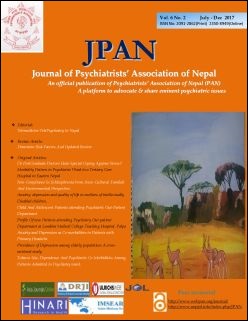Morbidity Pattern in Psychiatric Ward in a Tertiary Care Hospital in Eastern Nepal
DOI:
https://doi.org/10.3126/jpan.v6i2.21752Keywords:
Psychiatric illness, Inpatient, NepalAbstract
Introduction: Worldwide, the morbidity of psychiatric illnesses is on the rise. Quality in-patient services are a part of quality mental health services provision. Knowledge about the pattern of illness among patients admitted to the ward could help the service providers to plan better and provide better services. This study was undertaken to explore the clinico-demographic profile of patients admitted to psychiatric ward at BPKIHS..
Material And Method: This is a hospital based retrospective and cross-sectional study. After ethical approval from the Institutional Review Committee, the data of all patients admitted to Psychiatry Ward from 1st January 2007 to 31st December 2016 were collected from the data-base of Medical Records Section. The diagnoses were made according to the ICD-10 criteria. 3687 admissions were processed for the analysis.
Results: Of the 3687 admissions, 2183(59.2%) were male and 1504 (40.8%) were female. The age range was 4-92 years with mean age of 32.4(±12.6) years. The majority of the admissions (62.5%) were from Sunsari (1159,31.4%) and surrounding districts (1147,31.1%). Mood disorders were the commonest diagnoses 1788(48.5%) followed by schizophrenia, schizotypal and delusional disorders 829(22.5%) and psychoactive substance use disorders 813(22.1). 92% of patients admitted were improved on discharge and three cases expired in the ward. Out of 3687 admissions, 957(26%) were readmissions.
Conclusion: Mood disorders were the commonest diagnosis among the admitted patients. Outcome of hospital stay was good with 92% discharged in improved condition and only three mortalities in 10 years duration. Address seems to significantly affect the service utilization.
J Psychiatrists’ Association of Nepal Vol. 6, No. 2, 2017, Page: 15-21
Downloads
Downloads
Published
How to Cite
Issue
Section
License
This license enables reusers to distribute, remix, adapt, and build upon the material in any medium or format, so long as attribution is given to the creator. The license allows for commercial use.




